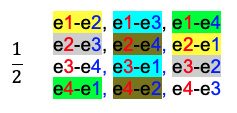The three dimensional Hamiltonian operator for an
-electron atom (excluding spin-orbit and other interactions) is:
where ,
and
or
where .
It is the total energy operator of the atom. The first term consists of the kinetic energy operators of the atom’s electrons and acts on a function of ,
and
. The second term, which is the electrostatic potential energy for the attractions between the electrons and the protons, acts on a function of just
because we have assumed an infinitely heavy nucleus that is reduced to a point at the origin. The third term, which acts on a function of
,
and
, is the electrostatic potential energy of electron repulsions. To illustrate the double summation for the last term, we consider a four-electron system with electrons e1, e2, e3 and e4. The possible interacting potentials, in the form of ej–ek, are:

which can be represented by the double summation . Note that this double summation can also be represented as
, which is illustrated as:

or , which is

To show that eq239 commutes with the components of the total orbital angular momentum operator , we consider a two electron system. As we know,
, where
and
are the individual orbital angular momentum of the system. Using eq76, we have
where ,
and
are components of
.
For the uncoupled case, where the orbital angular momenta of the two electrons do not interact, eq239 becomes . From eq103, eq104 and eq105, we have
and
, where
and
. This implies that the components of
and
commutes with
, and that
and
, and hence
and
. Therefore, when we analyse the commutation relations of the components of
and
with
, we are left with the commutation relations of the components of
and
with
.

Question
Show that the components of , but not those of
and
, commute with
.
Answer
Using eq74,
Similarly, the -components of the uncoupled operators
and
do not commute with with
. Therefore, all components of
and
do not commute with the Hamiltonian
.
Using the identity and substituting eq241 and eq242 into
, we have
. Similarly, we find that
and
. So,
Therefore, the components of the coupled total orbital angular momentum operator commutes with the Hamiltonian . If so, we can evaluate
using the identities
and
and eq243, which gives us
Finally, also commutes with
and
because
and spin angular momentum operators act on different vector spaces.

Question
Show that commutes with
, where
and .
.
Answer
Using the identities and
, and noting that every component of
commutes with every component of
because they act on different vector spaces, and that the components of
commutes with
because they act on different vector spaces, we have